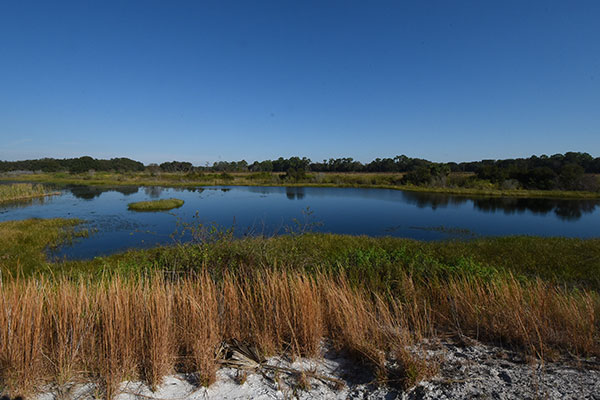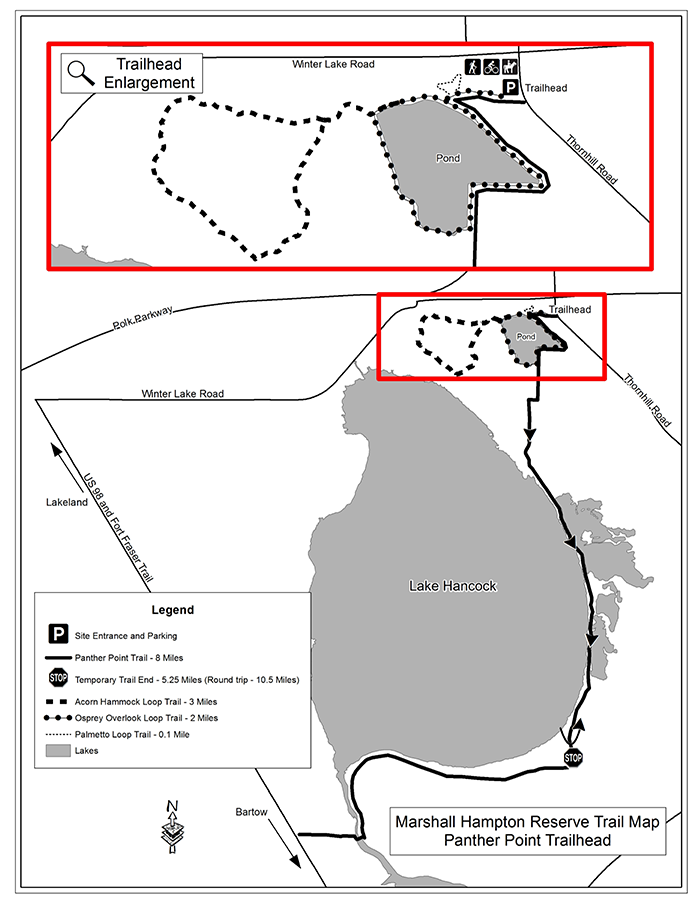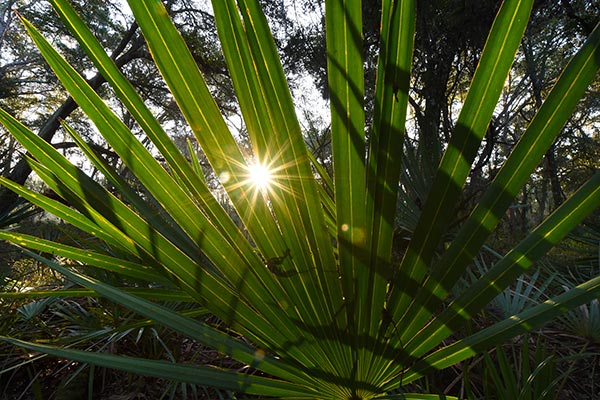Marshall Hampton Reserve
Nestled on the northeast edge of Lake Hancock, across the lake from Circle B Bar Reserve, lies Marshall Hampton Reserve. The Reserve has a interesting blend of oak hammock areas canopying over mesic flatwoods, hardwood forest wetlands and a 60-acre pond. The site, just more than 1,100 acres, is mostly dominated by live oaks, slash pine, sweet gum and palmettos. The two loop trails provide very different views of the property.
The site is open for horseback riding with a special use permit. To obtain a permit, call (863) 534-7377.
The Marshall Hampton Reserve was acquired by the Southwest Florida Water Management District in 2008. Polk County entered into an agreement with the Water Management District in 2010 to oversee the management of the property. The acquisition of this property also protected a significant amount of shoreline and floodplain swamp on the edge of Lake Hancock. Lake Hancock is often referred to as the headwaters of the Peace River.
Hiking/Jogging
Marshall Hampton Reserve provides more than seven miles of multiple-use trails for hikers and joggers to enjoy. The Acorn Hammock Loop Trail is a shaded trail, whereas the Osprey Overlook Loop Trail is a trail with no shade.
Horseback Riding
The trail lengths provide nice short rides for visitors on horseback. They are flat and are seasonally underwater. Horseback riders should be aware that the Osprey Overlook loop trail does have many holes along the trail.
Parking
Grass parking area is available. Access to the trailer parking for horses is allowed with a special use permit for horseback riding.
Osprey Overlook Loop Trail — (2.5 mile loop, Moderate, No Shade, Uneven Ground)
Osprey Overlook Loop Trail is a path that follows an elevated berm all the way around the 60-acre pond, an approximately 2.5 mile loop. Beware that this man-made feature is plagued with uneven ground and scattered holes. Hikers and horseback riders should watch their footing while traveling this trail. During extreme storm events, sections of this trail may washout and caution should be taken. The beauty of this trail is an elevated view of the pond and its wildlife. Wildlife watchers will enjoy watching the ospreys, cormorants, coots and eagles catching their prey. There are also a couple of resident alligators that patrol the shoreline, waiting for an easy meal.
Acorn Hammock Loop Trail — (3.5 mile loop, Moderate, Shaded)
Acorn Hammock Loop trail gives visitors the opportunity to hike a 3.5-mile shaded loop trail through a scenic oak hammock. The trail starts at the base of the pond, breaking away from the Osprey Overlook Loop Trail and then meanders into the oak hammock where it loops through historic pine flatwoods. The trail is mostly shaded. Trails may be seasonally wet; look for the old footbridges which allow visitors to cross some of the wetter areas.
Palmetto Loop Trail — (0.1 mile, Easy, Shaded)
Palmetto Loop is a short scenic path that gives visitors of all ages a chance to experience a shaded oak hammock within short walking distance to the parking area.
Panther Point Trail — (5.25 miles to temporary end, Moderate, Partially Shaded)
Phase 1 of the Panther Point Trail heads south, paralleling the eastern shore of Lake Hancock for about five miles to a temporary end. When completed, this trail will terminate at US Highway 98 and Ft. Fraser Trail. Hikers must now return to this trail head, so anticipate a 10+ mile hike if walking the length of the trail to the turnaround and back to the parking area. This trail winds through pastures, reclaimed mined areas, scenic swamps and has beautiful lakeshore vistas. Portions of the trail will be shared with cattle; please do not approach or disturb. Alligators may be observed on or crossing the trail so be alert and give them wide berth. There are no exits on the trail, so pace yourself and give yourself time and energy to make the return trip.
Cypress Dome Swamp
Freshwater swamps, such as cypress domes, contain water at least part of the year. Cypress trees lose their leaves in the winter, but bright green foliage appears again in the spring.
Pine Flatwoods
The flatwood community is dominated by pines such as longleaf and slash. Saw palmetto is abundant in the understory, along with blueberry, gallberry, fetterbush and the occasional frostweed aster.
Hammock
The hammock community contains remnant portions of wet, mesic and scrubby flatwoods. The absence of fire in these systems allows the woody trees such as oak to grow too large and the large trees start to shade out the plants growing closer to the ground.
Wildlife
Look for foxes, Sherman's fox squirrels, bobcats and deer. A variety of birds are here including wild turkey, hawks, owls, woodpeckers, warblers and migratory birds. Alligators are in the wet areas. Gopher tortoises and eastern indigo snakes also make their home on this site.
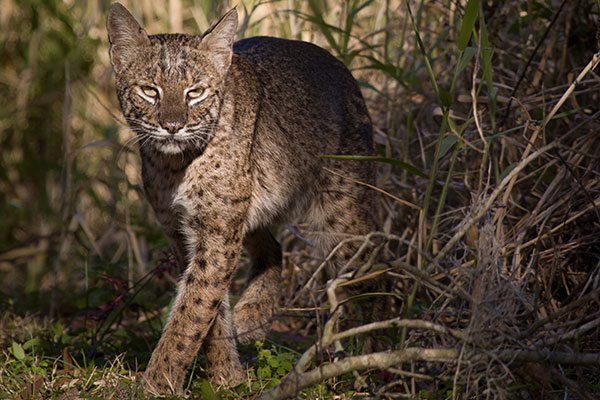
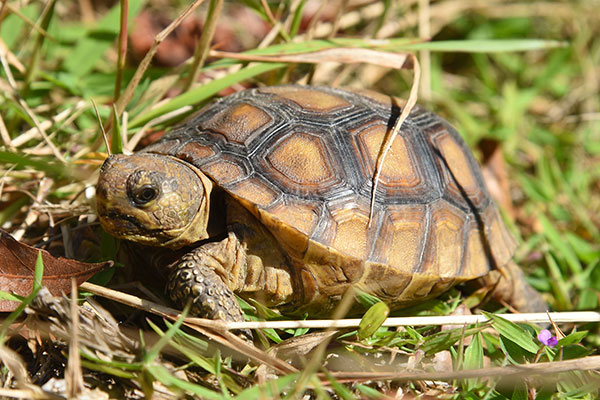
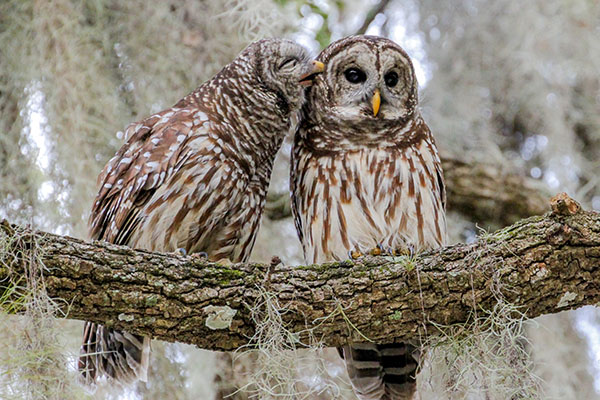
Wildflowers
The Marshall Hampton Reserve features three plant communities: pine flatwoods, live-oak hammocks and swamp forest. Pine flatwoods is characterized by longleaf pine, Pinus palustris in central Florida or slash pine, Pinus elliottii in south Florida and an understory predominantly of saw palmetto, Serenoa repens. Pines are shade intolerant and require fire to maintain the system. Some herbaceous flowering plants are rattlesnake master, Eryngium yuccifolium, large-flower milkweed, Asclepias connivens and elephant’s foot, Elephantopus elatus. Pine flatwoods also have a hardpan 8 to 10 feet below the surface.
The live oak hammock forms a canopy and is dominated by live oaks, Quercus virginiana and their epiphytes Spanish moss, Tillandsia usneoides, resurrection fern, Pleopeltis polypodioides and butterfly orchid, Encyclia tampensis and the terrestrial plant beggerweed, Desmodium incanum.
The swamp forest is found bordering north Lake Hancock and is composed of conifers, bald cypress, Taxodium distichum and hardwoods, black gum, Nyssa sylvatica, red maple, Acer rubrum and water oak, Quercus nigra, Virginia willow, Itea viriginica. Herbaceous plants are leather flower, Clematis crispa and mazus, Mazus pumilus.
Marshall Hampton Reserve is located in South Lakeland.
From Lakeland:
From Lakeland, take SR 98 south to Winter Lake Road. Travel east on Winter Lake Road to Thornhill Road. Travel south on Thornhill Road. The entrance is less than 0.25 miles on the right.
Location
Address
3115 Thornhill Rd.
Winter Haven, FL 33880
Hours of Operation
6 a.m. — 6:30 p.m. (Standard Time)
5:30 a.m. — 8 p.m. (Daylight Savings Time)
In This Section
